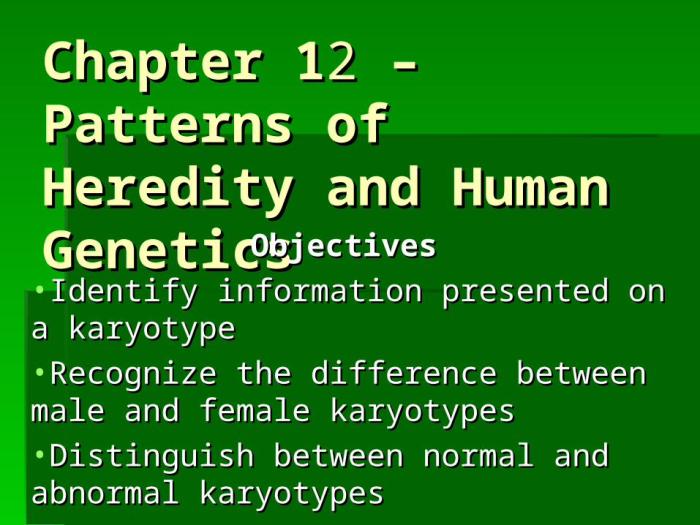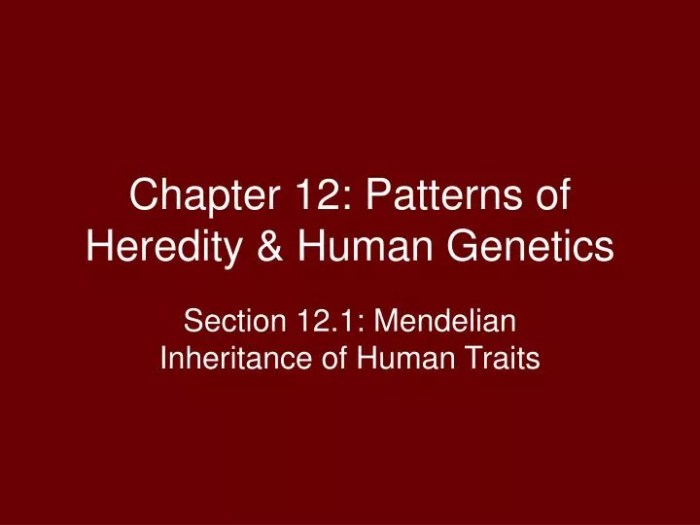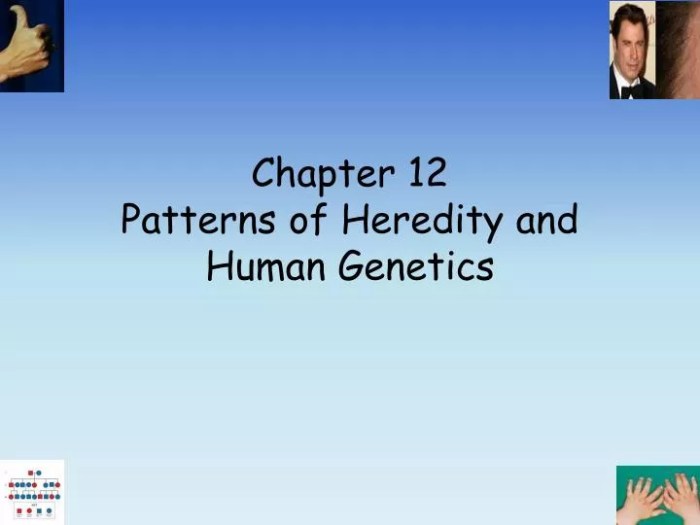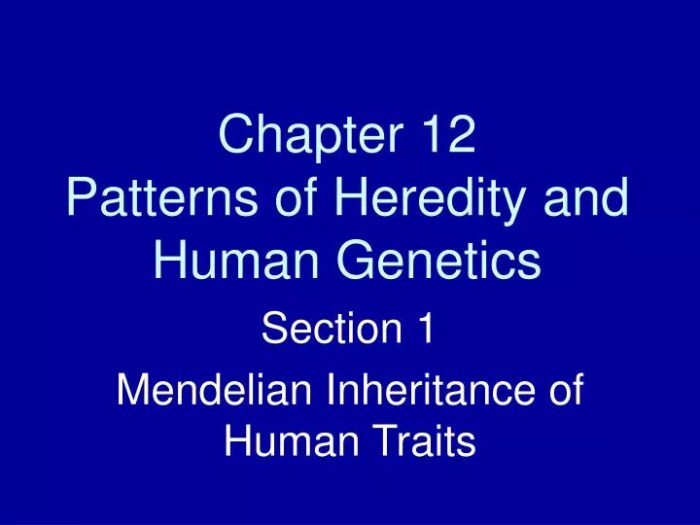Embark on a captivating journey into the realm of chapter 12 patterns of heredity and human genetics, where the mysteries of inheritance unfold. Delve into the intricate mechanisms that govern the passing of traits from parents to offspring, unraveling the complexities of dominant, recessive, and codominant patterns.
Discover the profound influence of heredity on human characteristics, shaping our physical and behavioral attributes.
As we delve deeper into human genetics, we uncover the structure and function of DNA and chromosomes, the building blocks of our genetic makeup. Witness the remarkable process of gene expression, where the blueprint of DNA is transformed into the proteins that orchestrate our biological functions.
Explore the impact of mutations on human traits, understanding their potential to alter our genetic heritage.
Patterns of Heredity

Inheritance is the process by which traits are passed from parents to offspring. Traits are determined by genes, which are located on chromosomes. Chromosomes are structures in the nucleus of cells that contain DNA. DNA is a molecule that contains the genetic information that determines an organism’s traits.
There are different patterns of inheritance. Dominant inheritance occurs when a trait is expressed in an individual who inherits one copy of the dominant allele for that trait. Recessive inheritance occurs when a trait is only expressed in an individual who inherits two copies of the recessive allele for that trait.
Codominant inheritance occurs when both alleles for a trait are expressed in an individual who inherits one copy of each allele.
Examples of Patterns of Heredity in Human Traits, Chapter 12 patterns of heredity and human genetics
- Eye color is an example of a dominant trait. The dominant allele for brown eyes is B, and the recessive allele for blue eyes is b. An individual who inherits one copy of the B allele and one copy of the b allele will have brown eyes.
- Sickle cell anemia is an example of a recessive trait. The dominant allele for normal hemoglobin is H, and the recessive allele for sickle cell hemoglobin is h. An individual who inherits two copies of the h allele will have sickle cell anemia.
- Blood type is an example of a codominant trait. The A allele for blood type A and the B allele for blood type B are both dominant. An individual who inherits one copy of the A allele and one copy of the B allele will have blood type AB.
Human Genetics

Structure and Function of DNA and Chromosomes
DNA is a molecule that contains the genetic information that determines an organism’s traits. DNA is made up of four different nucleotides: adenine (A), cytosine (C), guanine (G), and thymine (T). The sequence of these nucleotides determines the genetic code.
Chromosomes are structures in the nucleus of cells that contain DNA. Chromosomes are made up of proteins and DNA. The proteins help to package the DNA into a compact form. The DNA in chromosomes is divided into genes. Genes are the units of inheritance.
Process of Gene Expression
Gene expression is the process by which the information in a gene is used to make a protein. Gene expression occurs in two steps: transcription and translation.
Transcription is the process by which the information in a gene is copied into a messenger RNA (mRNA) molecule. mRNA is a molecule that carries the genetic information from the nucleus to the cytoplasm.
Translation is the process by which the information in an mRNA molecule is used to make a protein. Translation occurs on ribosomes, which are structures in the cytoplasm.
Role of Mutations in Human Genetics
Mutations are changes in the DNA sequence. Mutations can be caused by a variety of factors, including environmental factors and errors in DNA replication.
Mutations can have a variety of effects on human traits. Some mutations are harmful, while others are beneficial. Some mutations have no effect on human traits.
Genetic Disorders: Chapter 12 Patterns Of Heredity And Human Genetics

Types of Genetic Disorders
There are three main types of genetic disorders: chromosomal disorders, single-gene disorders, and multifactorial disorders.
- Chromosomal disorders are caused by changes in the structure or number of chromosomes. Down syndrome is an example of a chromosomal disorder.
- Single-gene disorders are caused by mutations in a single gene. Cystic fibrosis is an example of a single-gene disorder.
- Multifactorial disorders are caused by a combination of genetic and environmental factors. Heart disease is an example of a multifactorial disorder.
Causes, Symptoms, and Treatments of Common Genetic Disorders
The causes, symptoms, and treatments of common genetic disorders vary depending on the disorder.
Some common genetic disorders include:
- Down syndrome is a chromosomal disorder that causes intellectual disability and physical abnormalities. Down syndrome is caused by an extra copy of chromosome 21.
- Cystic fibrosis is a single-gene disorder that causes thick, sticky mucus to build up in the lungs and other organs. Cystic fibrosis is caused by a mutation in the CFTR gene.
- Heart disease is a multifactorial disorder that is caused by a combination of genetic and environmental factors. Heart disease is the leading cause of death in the United States.
Ethical Implications of Genetic Testing and Screening
Genetic testing and screening can be used to identify individuals who are at risk for developing genetic disorders. Genetic testing and screening can also be used to identify individuals who are carriers of genetic disorders.
There are a number of ethical implications associated with genetic testing and screening. These implications include:
- The right to privacy
- The right to know
- The right to choose
- The right to non-discrimination
Applications of Human Genetics

Use of Human Genetics in Medicine
Human genetics is used in medicine in a variety of ways, including:
- Genetic counseling
- Prenatal testing
- Gene therapy
Role of Human Genetics in Forensic Science and Anthropology
Human genetics is used in forensic science and anthropology to identify individuals and to study human evolution.
In forensic science, human genetics is used to identify criminals and to solve crimes. In anthropology, human genetics is used to study human evolution and to understand the relationships between different human populations.
Potential Benefits and Risks of Genetic Engineering and Other Emerging Technologies
Genetic engineering and other emerging technologies have the potential to revolutionize medicine and other fields. However, there are also a number of potential risks associated with these technologies.
Some of the potential benefits of genetic engineering and other emerging technologies include:
- Curing genetic diseases
- Improving crop yields
- Creating new materials
Some of the potential risks of genetic engineering and other emerging technologies include:
- Unintended consequences
- Ethical concerns
- Environmental risks
Query Resolution
What is the difference between dominant and recessive traits?
Dominant traits are expressed even when only one copy of the gene is inherited, while recessive traits are only expressed when two copies of the gene are inherited.
What is the role of mutations in human genetics?
Mutations are changes in the DNA sequence that can alter the function of genes and potentially lead to genetic disorders.
What are the ethical implications of genetic testing and screening?
Genetic testing and screening raise concerns about privacy, discrimination, and the potential for genetic information to be misused.